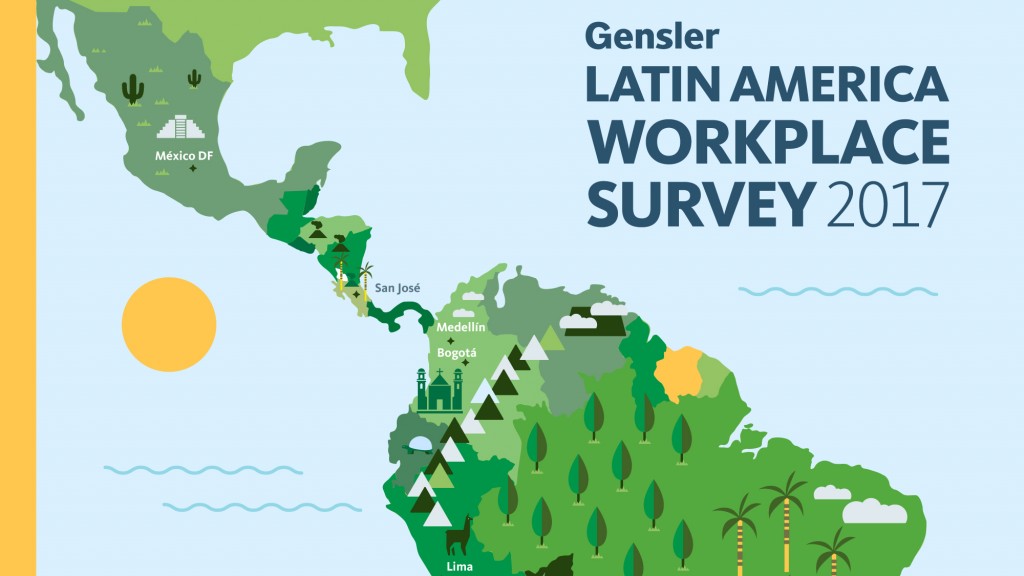How well is the Latin American workplace supporting the region’s knowledge workers, and what are the opportunities to improve?
Research Project Name
LATAM Workplace Survey 2017
What We Did
We surveyed an anonymous, panel-based sample of more than 4,000 office workers across nine major cities in Latin America. Our goal is to further develop our understanding of how and where people are working, and how well their spaces support that work. We used this information to understand the differences (and similarities) between Latin American workers and others around the world.
The Context
Latin America is a mix of Spanish- and Portuguese-speaking countries with a rich cultural legacy. The food, music and people who populate these dynamic countries and global cities—two of the 10 largest cities in the world are located in the region—bring deep influences that impact how, and where, work is done throughout the region.
The Results
Latin Americans work with others more than they work alone.
Typically known for their social nature, Latin American workers are very effective when working together—and it shows in how they spend their time. Compared to the other global regions surveyed in 2016 (US, UK and Asia).
Collaborative technology is a key innovation driver. A common theme among all 11,000+ workers surveyed across the globe in Gensler’s 2016 Workplace Surveys is the power of workplace design, the importance of seeing meaning in one’s work and the value that at-work relationships bring. These factors were key drivers of performance and innovation across all our surveys.
Local companies have an opportunity to improve. Given the importance of a workplace environment that recognizes culture, meaning and relationships, one might expect locally or regionally based companies to have higher performing workplaces. Global companies, however, are currently scoring higher on workplace effectiveness and innovation scores as compared to their local peers.
Collaborative technology is a key innovation driver. A common theme among all 11,000+ workers surveyed across the globe in Gensler’s 2016 Workplace Surveys is the power of workplace design, the importance of seeing meaning in one’s work and the value that at-work relationships bring. These factors were key drivers of performance and innovation across all our surveys.
Local companies have an opportunity to improve. Given the importance of a workplace environment that recognizes culture, meaning and relationships, one might expect locally or regionally based companies to have higher performing workplaces. Global companies, however, are currently scoring higher on workplace effectiveness and innovation scores as compared to their local peers.
What This Means
Provide places to work alone, together.
While employees in the region love to work together, our data also shows they love to work from home. While only a minority of their time is spent working from home, it has some of the highest effectiveness ratings. This speaks to the challenge of doing focused work in a vibrant office where everyone is collaborating.
Leverage global workplace trends to stay competitive. Global companies are currently setting the pace at which the workplace is changing. Regional and local companies have much to learn when it comes to space planning and technology. Given the importance of meaning and relationships to the employee experience, local companies should have a leg up on their global competitors if they are able to provide a physical environment that not only provides the right mix of spaces, but also reflects local culture and values.
Technology investments set innovators apart from the rest. Overall, technology and tools in Latin America are under-supported. But the region is also poised to get the most benefit out of greater technology investment and use. Companies should acknowledge the inherently social behavior of their workers and support it through workplace design and policy.
Leverage global workplace trends to stay competitive. Global companies are currently setting the pace at which the workplace is changing. Regional and local companies have much to learn when it comes to space planning and technology. Given the importance of meaning and relationships to the employee experience, local companies should have a leg up on their global competitors if they are able to provide a physical environment that not only provides the right mix of spaces, but also reflects local culture and values.
Technology investments set innovators apart from the rest. Overall, technology and tools in Latin America are under-supported. But the region is also poised to get the most benefit out of greater technology investment and use. Companies should acknowledge the inherently social behavior of their workers and support it through workplace design and policy.
What’s Next?
Understanding the work behaviors and environments at the national and regional level is a first step to identifying opportunities to improve the Latin American workplace. To drive more targeted conversations, these insights should be considered in light of the specific needs and work processes of individual organizations and work groups.
Learn More
Team
Jessica García, Francesca Poma-Murialdo , Jose Luis Sanchez-Concha, Tim Pittman, Christine Barber, Amrapali Agarwal.
Year Completed
2017
Comments or ideas for further questions we should investigate?
